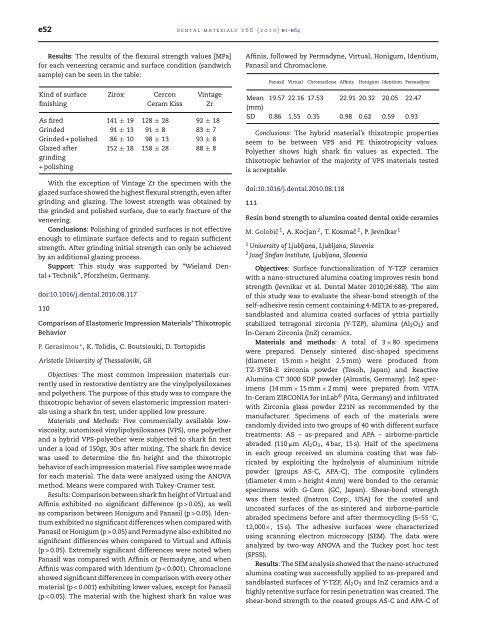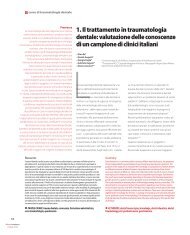Abstracts of the Academy of Dental Materials Annual ... - IsiRed
Abstracts of the Academy of Dental Materials Annual ... - IsiRed
Abstracts of the Academy of Dental Materials Annual ... - IsiRed
You also want an ePaper? Increase the reach of your titles
YUMPU automatically turns print PDFs into web optimized ePapers that Google loves.
e52 dental materials 26S (2010) e1–e84<br />
Results: The results <strong>of</strong> <strong>the</strong> flexural strength values [MPa]<br />
for each veneering ceramic and surface condition (sandwich<br />
sample) can be seen in <strong>the</strong> table:<br />
Kind <strong>of</strong> surface<br />
finishing<br />
Zirox Cercon<br />
Ceram Kiss<br />
Vintage<br />
Zr<br />
As fired 141 ± 19 128 ± 28 92 ± 18<br />
Grinded 91 ± 13 91 ± 8 83 ± 7<br />
Grinded + polished 86 ± 10 98 ± 13 93 ± 8<br />
Glazed after<br />
grinding<br />
+ polishing<br />
152 ± 18 158 ± 28 88 ± 8<br />
With <strong>the</strong> exception <strong>of</strong> Vintage Zr <strong>the</strong> specimen with <strong>the</strong><br />
glazed surface showed <strong>the</strong> highest flexural strength, even after<br />
grinding and glazing. The lowest strength was obtained by<br />
<strong>the</strong> grinded and polished surface, due to early fracture <strong>of</strong> <strong>the</strong><br />
veneering.<br />
Conclusions: Polishing <strong>of</strong> grinded surfaces is not effective<br />
enough to eliminate surface defects and to regain sufficient<br />
strength. After grinding initial strength can only be achieved<br />
by an additional glazing process.<br />
Support: This study was supported by “Wieland <strong>Dental</strong><br />
+ Technik”, Pforzheim, Germany.<br />
doi:10.1016/j.dental.2010.08.117<br />
110<br />
Comparison <strong>of</strong> Elastomeric Impression <strong>Materials</strong>’ Thixotropic<br />
Behavior<br />
P. Gerasimou ∗ , K. Tolidis, C. Boutsiouki, D. Tortopidis<br />
Aristotle University <strong>of</strong> Thessaloniki, GR<br />
Objectives: The most common impression materials currently<br />
used in restorative dentistry are <strong>the</strong> vinylpolysiloxanes<br />
and polye<strong>the</strong>rs. The purpose <strong>of</strong> this study was to compare <strong>the</strong><br />
thixotropic behavior <strong>of</strong> seven elastomeric impression materials<br />
using a shark fin test, under applied low pressure.<br />
<strong>Materials</strong> and Methods: Five commercially available lowviscosity,<br />
automixed vinylipolysiloxanes (VPS), one polye<strong>the</strong>r<br />
and a hybrid VPS-polye<strong>the</strong>r were subjected to shark fin test<br />
under a load <strong>of</strong> 150gr, 30 s after mixing. The shark fin device<br />
was used to determine <strong>the</strong> fin height and <strong>the</strong> thixotropic<br />
behavior <strong>of</strong> each impression material. Five samples were made<br />
for each material. The data were analyzed using <strong>the</strong> ANOVA<br />
method. Means were compared with Tukey-Cramer test.<br />
Results: Comparison between shark fin height <strong>of</strong> Virtual and<br />
Affinis exhibited no significant difference (p > 0.05), as well<br />
as comparison between Honigum and Panasil (p > 0.05). Identium<br />
exhibited no significant differences when compared with<br />
Panasil or Honigum (p > 0.05) and Permadyne also exhibited no<br />
significant differences when compared to Virtual and Affinis<br />
(p > 0.05). Extremely significant differences were noted when<br />
Panasil was compared with Affinis or Permadyne, and when<br />
Affinis was compared with Identium (p < 0.001). Chromaclone<br />
showed significant differences in comparison with every o<strong>the</strong>r<br />
material (p < 0.001) exhibiting lower values, except for Panasil<br />
(p < 0.05). The material with <strong>the</strong> highest shark fin value was<br />
Affinis, followed by Permadyne, Virtual, Honigum, Identium,<br />
Panasil and Chromaclone.<br />
Panasil Virtual Chromaclone Affinis Honigum Identium Permadyne<br />
Mean<br />
(mm)<br />
19.57 22.16 17.53 22.91 20.32 20.05 22.47<br />
SD 0.86 1.55 0.35 0.98 0.62 0.59 0.93<br />
Conclusions: The hybrid material’s thixotropic properties<br />
seem to be between VPS and PE thixotropicity values.<br />
Polye<strong>the</strong>r shows high shark fin values as expected. The<br />
thixotropic behavior <strong>of</strong> <strong>the</strong> majority <strong>of</strong> VPS materials tested<br />
is acceptable.<br />
doi:10.1016/j.dental.2010.08.118<br />
111<br />
Resin bond strength to alumina coated dental oxide ceramics<br />
M. Golobič 1 , A. Kocjan 2 , T. Kosmač 2 , P. Jevnikar 1<br />
1 University <strong>of</strong> Ljubljana, Ljubljana, Slovenia<br />
2 Jozef Stefan Institute, Ljubljana, Slovenia<br />
Objectives: Surface functionalization <strong>of</strong> Y-TZP ceramics<br />
with a nano-structured alumina coating improves resin bond<br />
strength (Jevnikar et al. <strong>Dental</strong> Mater 2010;26:688). The aim<br />
<strong>of</strong> this study was to evaluate <strong>the</strong> shear-bond strength <strong>of</strong> <strong>the</strong><br />
self-adhesive resin cement containing 4-META to as-prepared,<br />
sandblasted and alumina coated surfaces <strong>of</strong> yttria partially<br />
stabilized tetragonal zirconia (Y-TZP), alumina (Al2O3) and<br />
In-Ceram Zirconia (InZ) ceramics.<br />
<strong>Materials</strong> and methods: A total <strong>of</strong> 3 × 80 specimens<br />
were prepared. Densely sintered disc-shaped specimens<br />
(diameter 15 mm × height 2.5 mm) were produced from<br />
TZ-3YSB-E zirconia powder (Tosoh, Japan) and Reactive<br />
Alumina CT 3000 SDP powder (Almatis, Germany). InZ specimens<br />
(14 mm × 15 mm × 2 mm) were prepared from VITA<br />
In-Ceram ZIRCONIA for inLab ® (Vita, Germany) and infiltrated<br />
with Zirconia glass powder Z21N as recommended by <strong>the</strong><br />
manufacturer. Specimens <strong>of</strong> each <strong>of</strong> <strong>the</strong> materials were<br />
randomly divided into two groups <strong>of</strong> 40 with different surface<br />
treatments: AS – as-prepared and APA – airborne-particle<br />
abraded (110 �m Al2O3, 4 bar, 15 s). Half <strong>of</strong> <strong>the</strong> specimens<br />
in each group received an alumina coating that was fabricated<br />
by exploiting <strong>the</strong> hydrolysis <strong>of</strong> aluminium nitride<br />
powder (groups AS-C, APA-C). The composite cylinders<br />
(diameter 4 mm × height 4 mm) were bonded to <strong>the</strong> ceramic<br />
specimens with G-Cem (GC, Japan). Shear-bond strength<br />
was <strong>the</strong>n tested (Instron Corp., USA) for <strong>the</strong> coated and<br />
uncoated surfaces <strong>of</strong> <strong>the</strong> as-sintered and airborne-particle<br />
abraded specimens before and after <strong>the</strong>rmocycling (5–55 ◦ C,<br />
12,000×, 15 s). The adhesive surfaces were characterized<br />
using scanning electron microscopy (SEM). The data were<br />
analyzed by two-way ANOVA and <strong>the</strong> Tuckey post hoc test<br />
(SPSS).<br />
Results: The SEM analysis showed that <strong>the</strong> nano-structured<br />
alumina coating was successfully applied to as-prepared and<br />
sandblasted surfaces <strong>of</strong> Y-TZP, Al2O3 and InZ ceramics and a<br />
highly retentive surface for resin penetration was created. The<br />
shear-bond strength to <strong>the</strong> coated groups AS-C and APA-C <strong>of</strong>



